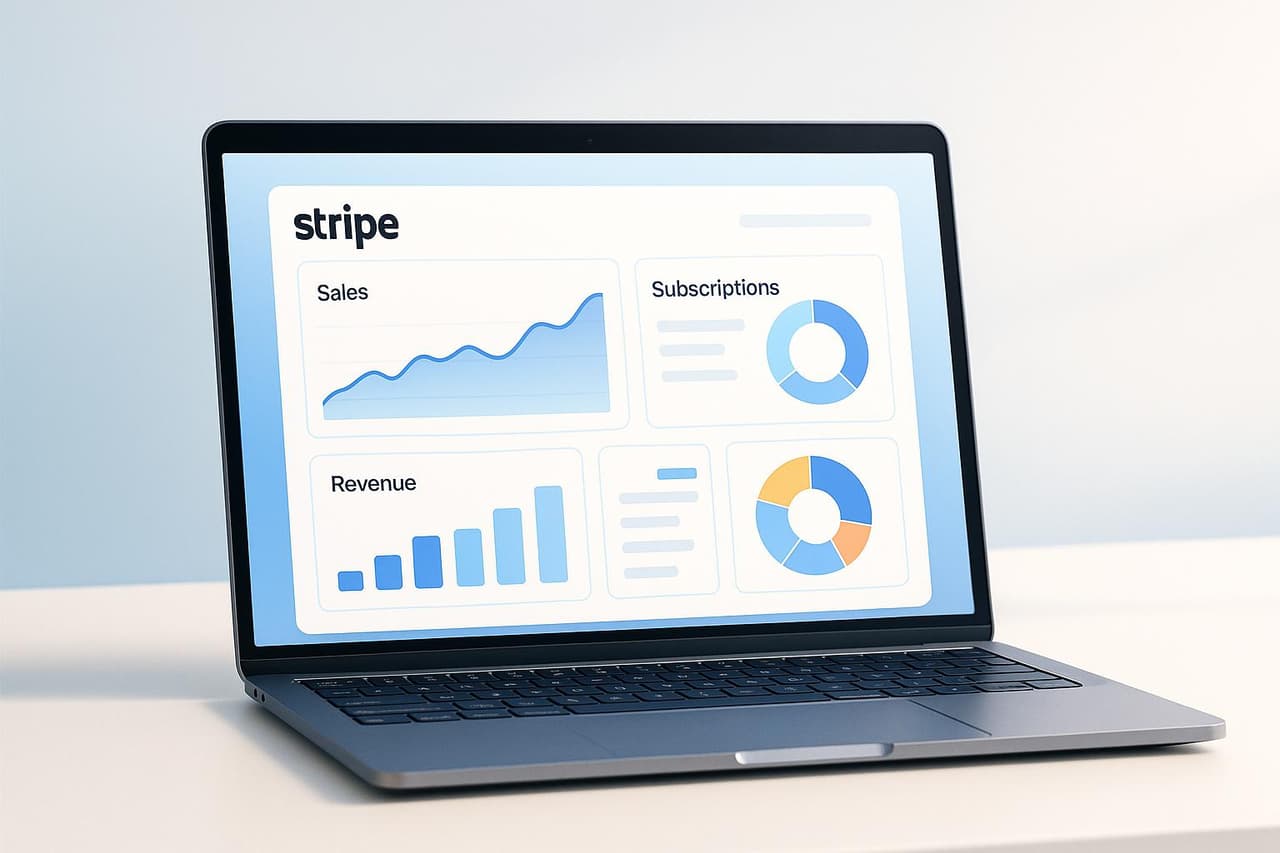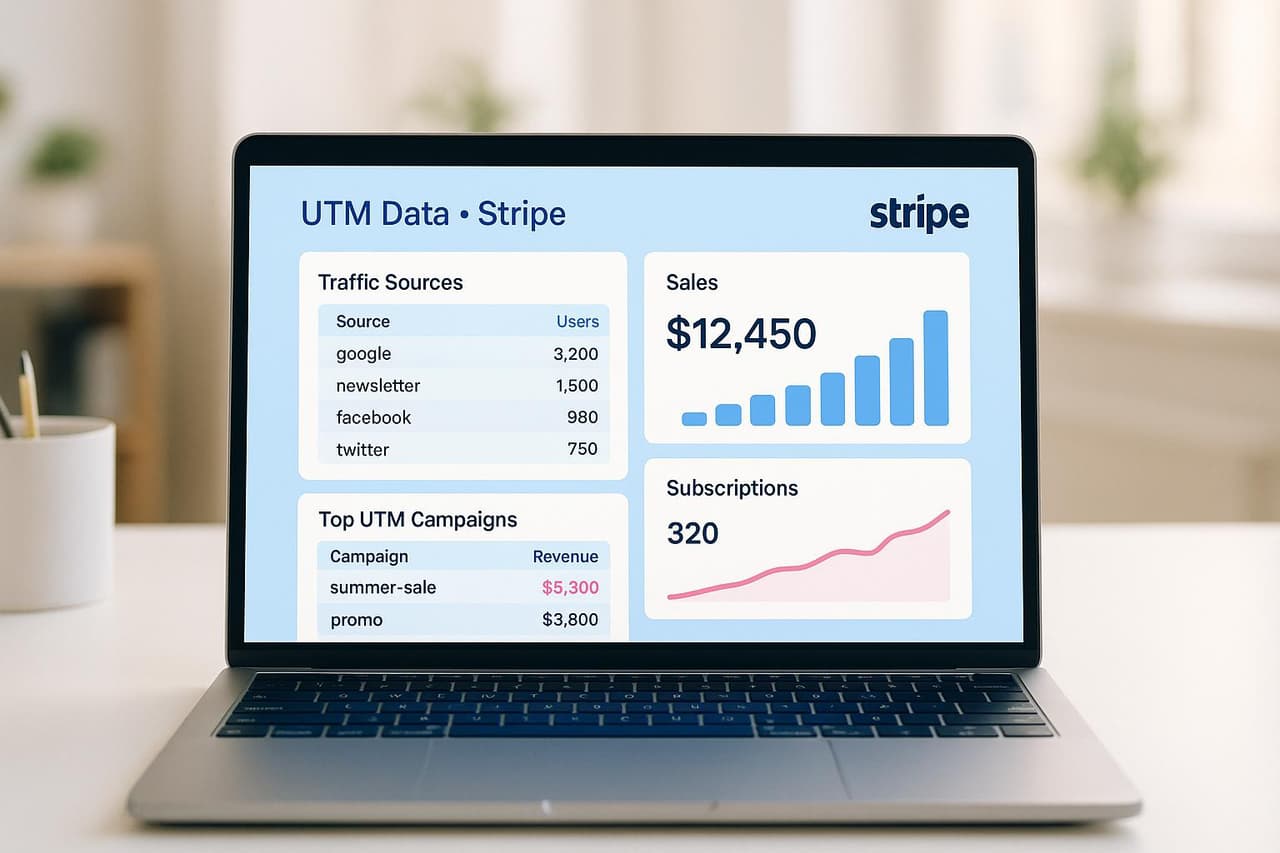
Stripe sales and subscription tracking can significantly improve your business's revenue insights and decision-making. Here's a quick guide to getting started:
- Use Stripe's Built-in Tools: Access key metrics like Monthly Recurring Revenue (MRR), churn rates, and active subscribers directly from the Stripe dashboard. Features like Smart Retries recover failed payments automatically.
- Set Up Webhooks: Automate event tracking (e.g., successful payments, subscription updates) to stay informed in real-time.
- Leverage UTM Parameters: Track the source of your sales by adding UTM codes to your Stripe payment links and checkout processes.
- Integrate No-Code Tools: Use platforms like Zapier to sync Stripe data with Google Sheets or Airtable for streamlined reporting.
- Monitor Retention and LTV: Analyze churn, subscription plan performance, and lifetime value (LTV) to refine your strategy.
Quick Comparison of Key Tools and Features
Stripe Product Walkthrough subscriptions
 Stripe
Stripe
Stripe's Built-in Tracking Features
Stripe's dashboard offers a range of tools to help businesses keep tabs on their sales and subscription performance. Here's a closer look at what it brings to the table.
Core Metrics in Stripe Dashboard
The dashboard provides insights into essential subscription metrics such as Monthly Recurring Revenue (MRR), active subscribers, trial conversions, churn rates, and collection efficiency. These metrics give businesses a clear picture of their subscription performance.
The "Explore" feature allows users to dive deeper into specific data, like churn trends or subscription expansions, offering more detailed insights into customer behavior [3].
One standout feature is Stripe's AI-powered Smart Retries, which helped recover 11% more revenue in 2023, reclaiming over $3.4 billion in failed payments [2].
Marketing Attribution Gaps
While Stripe excels in tracking subscription metrics, it has some limitations when it comes to marketing attribution:
"Accurate conversion tracking can be tricky, as in many cases the actual conversion (payment) happens outside of your website, in third-party systems like Stripe." - Team Tracklution [4]
Here are some of the challenges businesses face:
- Limited ability to integrate tracking codes into the payment process
- Difficulty tracking conversions from Stripe Payment Links
- Campaign data often gets lost during trial-to-paid transitions
- Cross-domain tracking issues create data gaps
These limitations can reduce the effectiveness of digital advertising efforts, as precise attribution data is critical for optimizing campaigns [4].
Setting Up Stripe Webhooks
Webhooks are a powerful way to monitor events and ensure accurate tracking of customer actions and payments. Here’s a quick overview of how to set them up:
- Create an endpoint to receive event data.
- Test locally using the Stripe CLI to ensure proper functionality.
- Register the endpoint with Stripe to start receiving events.
- Verify signatures to ensure data integrity.
- Set up event-specific monitoring for tailored tracking.
Stripe ensures reliability by attempting to deliver webhook events for up to three days in live mode [5]. Once implemented, webhooks can automate tasks like handling invoices, updating customer records, triggering notifications, and syncing with other tools [6].
For further customization, metrics definitions in the Billing overview can be configured to calculate MRR, churn, and active subscriber data based on your specific needs [3]. Additionally, Stripe's recovery tools boast an impressive 57% recovery rate for failed recurring payments [2].
Next, we’ll dive into how UTM parameters can take sales attribution to the next level.
UTM Parameter Setup for Sales Attribution
Building Your UTM Structure
To track the origins of Stripe sales effectively, you need to set up UTM parameters thoughtfully. Here's how to structure them:
Keep your UTM parameters concise - ideally under 150 characters - and stick to alphanumeric characters, dashes, or underscores to avoid errors [7].
UTM Tracking Through Stripe Checkout
Once your UTM parameters are structured, the next step is ensuring they carry through the checkout process seamlessly.
- Set Redirect Behavior: Configure Stripe Checkout to use the
redirectconfirmation option [7]. - Use Client Reference IDs: Leverage the
client_reference_idfor every checkout session to maintain consistent tracking [7].
"Modify your payment link with URL parameters and Urchin Tracking Module (UTM) codes to get insight into customer behaviors and your marketing strategy's effectiveness. These tools help identify the source of your traffic and the marketing campaigns leading to the most conversions." - Stripe Documentation [7]
Maintaining UTM Data Accuracy
Preserving the integrity of your UTM data is critical, especially when transitioning from client-side to server-side tracking. A few essential strategies include:
- First-Party Cookies: Use first-party cookies to ensure data accuracy and add
checkout.stripe.comto the referral exclusions in Google Analytics 4 [8][10]. - URL Shorteners: For long UTM-tagged URLs, use URL shorteners to simplify links while keeping tracking intact [9].
It starts here
If you made it this far, it's time to grab 10 free links.
10 smart links included • No credit card
No-Code Tools for Stripe Data Tracking
Tracking Stripe data can be tricky, but no-code tools like Zapier make it easier by simplifying data integration and improving access - no heavy coding required.
Connecting Stripe to Other Tools via Zapier
 Zapier
Zapier
Zapier acts as a bridge between Stripe and other essential business tools, enabling automated data tracking. For example, you can connect Stripe to Google Sheets or Airtable to automatically log customer details, payments, and UTM data into a single, organized database [11].
"By leveraging Stripe's subscription feature, I'm able to get paid faster for many of my recurring revenue relationships. Additionally, the real-time visibility of top clients based on total payments is a great reminder of where I should be spending most of my time to better nurture, serve, and expand those top-tier relationships" [14].
Next, let’s dive into how to set up instant updates using event notifications.
Setting Up Event Notifications
You can stay on top of key events in Stripe by setting up notifications. Here’s how:
-
Webhook Endpoints: In your Stripe dashboard, create webhook endpoints and select the events you want to track. For example:
-
Notification Channels: Use Zapier to connect Stripe events to tools like Slack. For instance, you can set up Slack alerts for successful sales or payment failures, ensuring your team can respond quickly [12].
Creating Sales Performance Dashboards
Once your data flows and notifications are automated, building dashboards to track performance becomes much simpler. These dashboards can give you a real-time view of your Stripe data. Recent stats show that 43% of software businesses plan to launch subscription models within the next five years [14].
When designing your dashboard, consider including the following key metrics:
"As founders, we need to go custom for the things that really make us stand out, and ruthlessly prune and go for best-in-class external offerings for the rest, especially in this hypercompetitive and more capital-constrained macro environment" [14].
To keep your data reliable, make sure your dashboard syncs with Stripe at regular intervals [13]. This ensures you’re always looking at the most up-to-date information.
Advanced Analytics Without Code
Building on automated data flows from no-code tools, advanced analytics platforms make it possible to dive deep into Stripe data without writing a single line of code.
Sales Funnel Analysis
Understanding your customer journey - from the first interaction to recurring payments - is key to improving conversions. No-code dashboards make it easy to track every stage of your sales funnel. Here's how different tools can support your analysis:
These insights provide a strong foundation for diving deeper into retention metrics.
Subscription Retention Analysis
Retention analysis goes beyond funnel metrics, helping you refine your revenue strategy. By tracking key metrics like these, you can fine-tune your approach:
- Monthly Recurring Revenue (MRR): Keep tabs on changes over time.
- Churn Rate: Analyze customer attrition by segment.
- Subscription Plan Conversions: Measure the effectiveness of your plans.
- Failed Payment Recovery: Monitor how often failed payments are recovered.
For instance, Hex adopted Stripe Billing's usage-based pricing features in 2024 to improve retention and streamline billing. Within just three months, a large portion of their customers had migrated to the new model [15].
Customer LTV Calculations
Customer Lifetime Value (LTV) is a critical metric for deciding where to focus your marketing dollars and acquisition efforts. No-code platforms simplify LTV calculations by seamlessly integrating Stripe data with business intelligence tools.
Here are some strategies that have been shown to improve LTV:
Conclusion: Next Steps for Better Stripe Tracking
Tracking Stripe data effectively requires a structured approach to ensure high-quality data and seamless integration. Start by standardizing your UTM tracking - use lowercase letters and underscores to maintain consistent attribution data [18].
Here’s a roadmap to guide your implementation:
These steps build on earlier strategies to refine your Stripe tracking process. Integrating these actions with your current tools will simplify reporting and improve data accuracy.
Focus on these priorities moving forward:
- Centralize your billing system to manage all revenue streams in one place [16].
- Enable real-time updates to ensure immediate reflection of any changes [16].
- Strengthen data security with advanced protection protocols [16].
FAQs
How do I use UTM parameters with Stripe to track where my sales are coming from?
To monitor where your sales are coming from using Stripe, you can include UTM parameters in your payment link URLs. These parameters let you track details like the source (e.g., YouTube, email), the medium (e.g., paid ads, organic traffic), and the campaign name tied to each sale. Once a customer completes their payment, the UTM data is sent to the success URL, giving you the tools to analyze which marketing channels are generating revenue.
To make the most of this, stick to consistent naming conventions for your UTM parameters. This keeps your data organized and makes it easier to evaluate how well your campaigns are performing. Incorporating this practice into your routine can provide valuable insights into customer behavior and help you refine your marketing strategies.
How can no-code tools like Zapier improve Stripe sales and subscription tracking?
Integrating no-code tools like Zapier with Stripe can transform the way you manage sales and subscriptions. By automating repetitive tasks, you save time and minimize the chance of manual errors. Plus, it ensures seamless data sharing between Stripe and other platforms, streamlining your operations.
What’s even better is that no-code tools let non-technical users design workflows that suit their specific needs. This makes it simple to connect data from multiple sources, giving you a clearer view of revenue, customer behavior, and subscription trends - all without needing advanced technical skills.
How do webhooks help track Stripe events and improve business efficiency?
Webhooks offer a smart way to stay updated on Stripe events in real-time, like payments, subscription changes, or disputes. They work by instantly notifying your application whenever a specific event happens. This means you can automate tasks such as updating customer information or sending out confirmation emails without needing to constantly check the API. It’s a time-saver and reduces resource usage.
On top of that, webhooks can help tighten security by quickly flagging suspicious activity and keeping your payment data accurate. They also improve the customer experience by providing instant updates on payment statuses, which helps reduce uncertainty and builds trust. In short, webhooks make managing your Stripe data smoother and more reliable, so you can focus on what really matters - growing your business.



